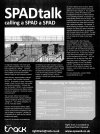GC class B1
Member
To clarify, Wheel Slide Prevention (WSP) is a system generally fitted to disc braked vehicles to prevent wheelsets locking when braking in low adhesion conditions. It will apply and release the brakes to prevent the wheelset locking and is similar to ABS on cars. Wheel Slip Prevention is fitted to wheelsets that are motored to prevent the wheelset spinning when under power in low adhesion conditions. There is also a system called WSSP which works on motored axles to prevent both slip and slide.
Last edited:

